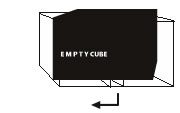NUNO SOUSA VIEIRA
NOVEMBER, 13, 2008

CONTACT
nunosousavieira@gmail.com
http://www.e-vai.net/content/view/1381/1/
EXHIBITION INFORMATION
Redrawing
Corner table
2008
Acrilyc paint on wood
77,5 x 140 x 82,5 cm
Project of corner for rectangular table (instructions)
2008
Digital and offset print
29,7 x 21cm
Half Isometric Skcethbook
2008
21 x 14,85 cm
Limited Edition: 100 copies
Procedures.
The works that constitute this project by Nuno Sousa Vieira stem from a precise, schematic conceptual construction, which generates various formulations of this artist’s reflections on the relations between his working method and the spectator. A common denominator to all these pieces quickly becomes obvious: meticulous execution is present in all the media employed, such as sculpture, printed instructions and the notebook. At the root of that meticulous execution lies a conceptual structure that relies heavily on geometry, an important element during the conception phase of his pieces, which activates a connection between studio space and exhibition space. This interaction between the visible element of the exhibited works and the experimental work in the studio combines Nuno Sousa Vieira’s schematic – or mathematic – thinking with a poetics that inspires the spectator with the notion of an itinerary, whose starting-point lies at the moment of confrontation with the works.
The title Redesenhar [Redrawing] indicates a systematic procedure intended for an indeterminate individual, who is also given the possibility of bringing about a reconfiguration or transformation. The exhibition takes the form of a provisory phase, in which we are proposed an exercise on our relationship with the work of art and its contextualisation. This exercise does not consist in an inner, subjective process in which one tries to remember references from art history in the presence of the Mesa de canto [Corner table] sculpture, but rather in sharing the transformation process we witness. The piece, built and modified by the artist, intersects the space, creating a chain of meaning that is close to a seeming tautology. There is an epidermic relationship between overlapping planes, such as the floor and the sculpture’s base, a permeable substance that contains a double meaning. The base is the table’s top, as the referent of a reproducible object which can only be guessed by means of the title and some recognisable elements in the sculpture. A similar association occurs between a certain geometric feature that is shared by both the space and the table: two horizontal planes on which two corners with 90º angles concur and coincide.
Rather than being simply concerned with the work’s composition in space, proportion moves away from the potential fetishisation of the object and place to become another part of this system of thought, which emerges from a methodology of the representation of a three-dimensional object on a two-dimensional plane. Yet, geometry is only the foundation of a more complex process that leads us into a deception. The finish and selection of the materials employed here force us to reassess the value of the representation, as well as the power it wields as the site of collective memory.
The three exhibited works share a common feature: the possibility of allowing the spectator to take part in the working process, rather than simply contemplating the pieces. This feature is present in the instructions written on another exhibit, Projecto de canto para mesa rectangular (instruções) [Project of corner for rectangular table (instructions)], which describes the necessary steps taken to carry out the operation to which the original object was subjected. The displayed instructions allow the spectator to contact with the artist’s procedure. This approach is not concerned with offering a model for the reproduction or trivialisation of the method, but with creating a close connection between the public and private spheres. This connection is completed by the piece caderno meio isométrico [semi-isometric notebook], which is based on a notebook, an instrument used for taking notes or sketching. This piece, conceived by the artist and typographically reproduced, is made available to the public, thus crossing over to the private sphere of the individual. The special quality of this notebook lies in the element of predetermination brought by the artist, which reconfigures its original use. The notebook’s leaves are printed with a grid that, unlike what could be expected, is an isometric structure that can be used for writing, drawing, or simply for being looked at. Each individual will separately decide which use to give the notebook, adding to that drawing, which is symmetrically reproduced in every page, their own personal touch.
In this exhibitive project, drawing is a process that stretches across time, and is not limited to a gestural practice with immediately visible results. Redrawing is more than just a mere starting-point: it is a deconstructive, shared action that changes and repositions acquired codes and methodologies.
João Silvério
October 2008




